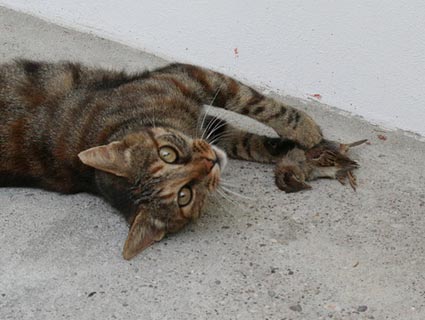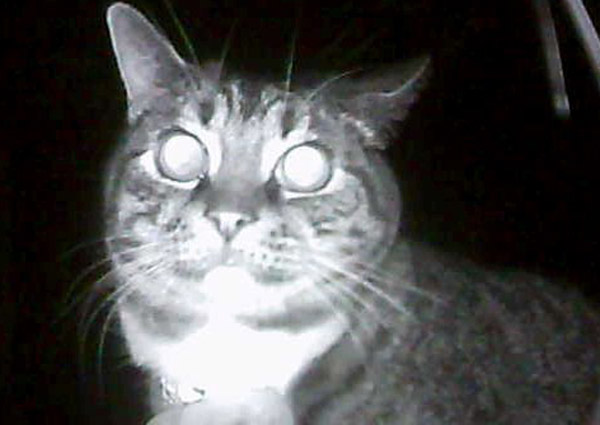 LOOK INTEW MAI EYEZ. Night kitteh sez resistance is futile. University of Georgia and National Geographic Remote Imaging
LOOK INTEW MAI EYEZ. Night kitteh sez resistance is futile. University of Georgia and National Geographic Remote Imaging
A new study from the University of Georgia affirms your deepest, darkest suspicion, America: Your little kitty witty cat may be out for blood behind your back.
University researchers outfitted 60 pet kitties in Athens, Ga. with three-ounce video cameras provided by National Geographic to figure out what the heck cats do all day when they’re turned loose into the suburban wild. Between November 2010 and October 2011, the “Kitty Cams” captured more than 2,000 hours of life in the seedy underbelly of neighborhood fauna, revealing that Princess Fluffywuffykins and her fuzzied ilk are likely killing a lot more critters than the precious gifts they leave for you and your dustpan on the doorstep.
“All the previous studies were based on counts of things brought to the house and this time in this study, we found that cats don’t bring most of their prey back to their house,” ecologist Kerrie Anne Loyd, the lead author of the study, explained. “So the previous studies were missing a huge portion of captures from hunters.”
About 30 percent of the sampled cats were successful hunters and killed, on average, two animals a week. Almost half of their spoils were abandoned at the scene of the crime. Extrapolating from the data to include the millions of feral cats brutalizing native wildlife across the country, the American Bird Conservancy estimates that kitties are killing more than 4 billion animals annually. And that number’s based on a conservative weekly kill rate, said Robert Johns, a spokesman for the conservancy.
“We could be looking at 10, 15, 20 billion wildlife killed (per year),” Johns said.
The kill footage, Loyd noted, is “pretty horrible to watch,” which is why you’ll find a video of kitteh finding tasty Chex Mix on her research website, but not kitteh dismembering Woodland Vole. One pet owner, Evet Loewen, was particularly scandalized by what she saw and almost dropped out of the study. After downloading a day’s worth of video recordings from her cat Ursa’s Kitty Cam, she caught the former feral committing the Unspeakable.
“You could see her whiskers and you could see her staring at the sky, looking at the trees…and in this particular instance…it was clear that she was under the deck of my house and had a bird,” Loewen said. “And she hadn’t ripped the bird apart yet, but it was clear that the bird was in great distress and it was very upsetting.”
“I stopped watching because I knew what the end point was, that the bird wasn’t going to live. I was very upset with my cat.”
The feline propensity for food-play is a well-documented phenomenon (See “Cat Breading“), so this is nothing new. But what was surprising about the killings, according to Loyd, was the kitties’ penchant for scaly, cold-blooded flesh: The most common prey were Carolina anoles, followed by small mammals and finally, birds. (But lizards! Gross! So who cares.)
To stop Ursa’s onslaught on animal-kind, Loewen took the advice of the UGA researchers and outfitted her naughty kitty with a cat bib and bell attachment, effectively disabling any of Ursa’s predatory prowess.
“She still likes to sit down and watch birds, but she cannot get them at this point because her movements are so inhibited,” Loewen said. “She can be outside and she can look at the birds all she wants but she gets up and this bell goes right off.”
The fine, feathered creatures of Athens can sleep peacefully tonight, knowing one more feline enemy-combatant is off the streets for good.
Meanwhile, here are the cat photos you came here for:
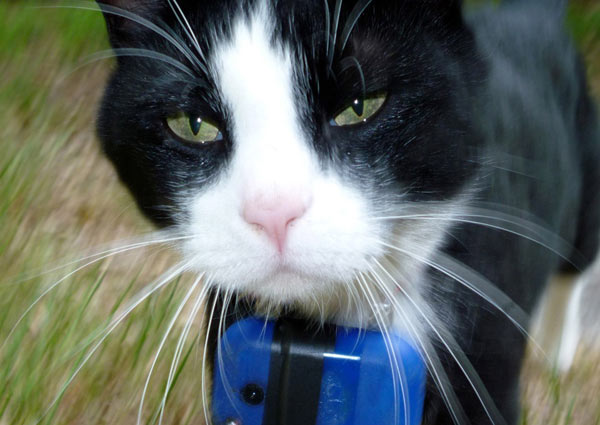 Grumpy kitteh sez collars are “fur” dogs. (LOL!) University of Georgia and National Geographic Remote Imaging
Grumpy kitteh sez collars are “fur” dogs. (LOL!) University of Georgia and National Geographic Remote Imaging
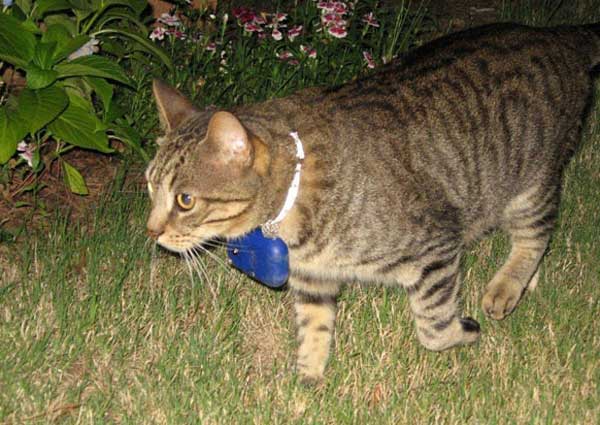 Prowling kitteh stalks wildlife, looking for noms. University of Georgia and National Geographic Remote Imaging
Prowling kitteh stalks wildlife, looking for noms. University of Georgia and National Geographic Remote Imaging
 Car kitteh disapproves of your crummy park job. University of Georgia and National Geographic Remote Imaging
Car kitteh disapproves of your crummy park job. University of Georgia and National Geographic Remote Imaging
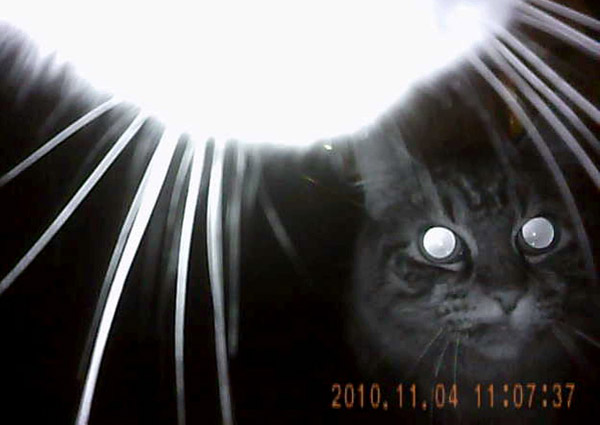 Night kitteh’s eyes penetrate your soul. University of Georgia and National Geographic Remote Imaging
Night kitteh’s eyes penetrate your soul. University of Georgia and National Geographic Remote Imaging
Consumers of the Internet, behold more Kitty Cam photos here.


